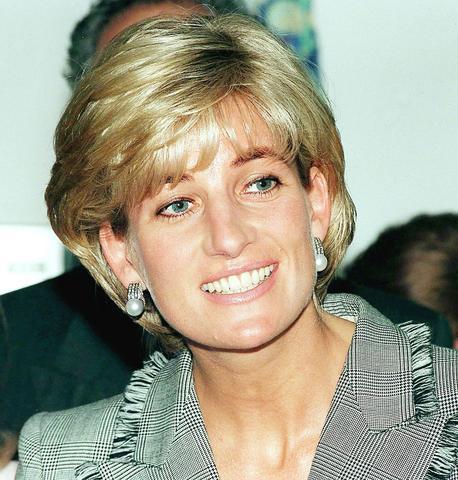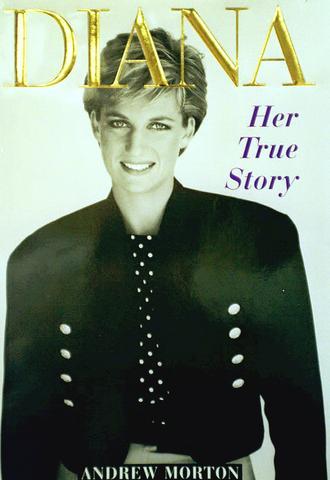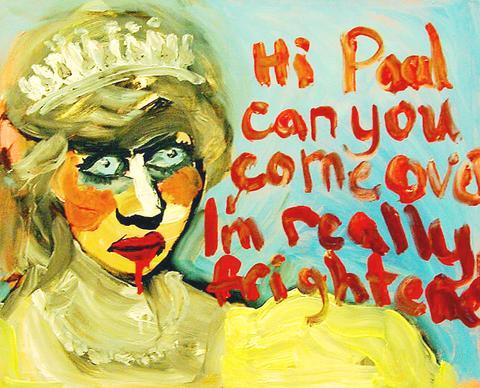There was really nothing new in the Princess Diana audiotapes aired for the first time Thursday night on American television.
Most of it is familiar from Andrew Morton's 1992 best-selling book, Diana, Her True Story, which is based on the five hours of audiotapes.
But nearly seven years after Diana's violent death in a Parisian highway tunnel car crash, the prospect of actually hearing her voice tell of her depression and bulimia, royal family indifference and search for inner strength was a magnet that far out-trumped any of the modern-day propensity for stars and ordinary people to divulge their innermost feelings over the public airwaves.

PHOTO: AFP
It was in fact a voice from the grave of an icon, a secret autobiography recorded under cloak-and-dagger conditions by a close friend, with her knowledge and approval but out of sight of the palace minders. NBC television, which acquired the tapes for an undisclosed amount, must be making a financial killing from the two-part broadcast.
And yes, the tapes revealed things about Diana that did not come across on the printed page.
Diana's sighs and giggles and matter-of-fact description of emotionally traumatic events, for example, don't appear in the book.

PHOTO: AP
She pours out her sadness as she talks about her pain and anguish at age 18, on the eve of her fairy-tale wedding to Prince Charles in 1981. She is desperately in love with the 30-year-old heir to the British throne, yet already aware there was another woman in his life.
She talks about gorging on food and throwing up before the event, already overwhelmed by the voracious public appetite for every detail of her existence. Photographers have been peeping into her apartment window, where she lived when she worked as a kindergarten teacher.
"My wedding day, I think that was the worst day of my life," Diana said.

PHOTO: AP
"I said, I can't marry him, I can't do this. [But her family said] bad luck, doll, your face is already on the tea towel," Diana recalled in soft tones. "I knew I couldn't do anything about it."
In the book, Charles emerged as a callous cad who plucked Diana to satisfy the royal family's demands that he finally marry and produce some offspring, while continuing his dalliance with the married Camilla Parker Bowles.
Diana later was granted a divorce, in 1996, and she became strong enough to make her fight against bulimia public and to tackle social issues such as land mine clearance in Africa and AIDS.
But Diana actually giggles when asked about the days after the all-out royal wedding in Westminster Cathedral.
"The wedding night was strange. I just had tremendous hope in me, which was slashed by day two," she says. She takes a breath, pauses to giggle, then continues to describe how Charles lugged along eight novels by his philosopher-hero, Laurens van der Post, to read during their honeymoon.
Diana was "exhausted" by her honeymoon turmoil, but for all the "wrong reasons," she said, laughing again. Her husband preferred the books to the marriage bed.
On the trip, which took them to Egypt, she recalls how Charles wore cufflinks with two entwined Cs engraved on them for Charles and Camilla as the royal couple prepared to meet with president Anwar Sadat. She challenged him, and asked him if they were a present from Camilla. He said yes.
"And boy, did we have a row," she says, with a kick of pride in her voice.
When the book appeared, the royal family could not figure out how Morton had managed to interview Diana, whose every step was controlled by the palace. In fact, Diana had approached Morton through a mutual friend, James Colthurst.
After seeing her suffer for 10 years in the marriage, Colthurst knew that Diana was bursting with unhappiness at Charles, and suggested the book idea.
"She was going to say something anyway," Colthurst said. "She had the choice of doing it as a loose cannon, or controlling the outcome, which she was able to do with the book."
Diana, Colthurst, Morton and the publisher conspired from the beginning to keep things secret, and the three men often met clandestinely in out of the way places to cloak their project.
Colthurst, who carried questions written out by Morton and a tape recorder on his visits to her home at Kensington Palace, said Diana needed little encouragement to talk. He sometimes rode a bike on the visits, and had easy access to the quarters as an old friend.
"She just started at the beginning of her childhood and kept going," Colthurst said in the NBC interview. "And it was obviously something she wanted to do."
Morton said Diana had been "conned" and "lured" into the marriage and the palace.
In Thursday's program, Diana also talks about the birth of William and Harry in 1981 and 1984, and her desperate unhappiness and postnatal depression passed off by Charles as "crying wolf." She tried to commit suicide during one of the pregnancies, throwing herself down the stairs. Another time she tried to slit her wrists.
"My husband made me feel so, ummm, inadequate in every possible way so that each time I came up for air, he'd push me down again," she says.
The final blow, she said, was his reaction to the birth of Harry, whose red hair "horrified" him and who disappointed Charles because he was a boy.
"Charles had been hoping for a girl. Suddenly as Harry was born, it just went bang down the drain," she says.
"`Oh god, he's even got red hair,'" Diana quotes Charles as saying.

Oct. 21 to Oct. 27 Sanbanqiao Cemetery (三板橋) was once reserved for prominent Japanese residents of Taipei, including former governor-general Motojiro Akashi, who died in Japan in 1919 but requested to be buried in Taiwan. Akashi may have reconsidered his decision if he had known that by the 1980s, his grave had been overrun by the city’s largest illegal settlement, which contained more than 1,000 households and a bustling market with around 170 stalls. Fans of Taiwan New Cinema would recognize the slum, as it was featured in several of director Wan Jen’s (萬仁) films about Taipei’s disadvantaged, including The Sandwich

“Wish You Luck is not just a culinary experience, it’s a continuation of our cultural tradition,” says James Vuong (王豪豐), owner of the Daan District (大安) Hong Kong diner. On every corner of Kowloon, diners pack shoulder-to-shoulder over strong brews of Hong-Kong-style milk tea, chowing down on French Toast and Cantonese noodles. Hong Kong’s ubiquitous diner-style teahouses, known as chachaanteng (茶餐廳), have been a cultural staple of the city since the 1950s. “They play an essential role in the daily lives of Hongkongers,” says Vuong. Wish You Luck (祝您行運) offers that same vibrant melting pot of culture and cuisine. In

Much noise has been made lately on X (Twitter), where posters both famed and not have contended that Taiwan is stupid for eliminating nuclear power, which, the comments imply, is necessary to provide the nation with power in the event of a blockade. This widely circulated claim, typically made by nuclear power proponents, is rank nonsense. In 2021, Ian Easton, an expert on Taiwan’s defenses and the plans of the People’s Liberation Army (PLA) to break them, discussed the targeting of nuclear power plants in wartime (“Ian Easton On Taiwan: Are Taiwan’s nuclear plants safe from Beijing?”, April 12, 2021). The

Artificial intelligence could help reduce some of the most contentious culture war divisions through a mediation process, researchers say. Experts say a system that can create group statements that reflect majority and minority views is able to help people find common ground. Chris Summerfield, a co-author of the research from the University of Oxford, who worked at Google DeepMind at the time the study was conducted, said the AI tool could have multiple purposes. “What I would like to see it used for is to give political leaders ... a better sense of what people ... really think,” he said, noting surveys gave